The image for this multiclassing combinations content is “Battle of heroes” by linweichen, CC Attribution-Noncommercial-No Derivative Works 3.0 License
Disclaimer: This article contains affiliate links that add gold to our coffers.
From increasing utility to developing a beautiful character arch, multiclassing can have multiple benefits—if you choose the right combination. If you’re a little hazy on how to multiclass, see our article that quickly and clearly explains the multiclassing rules and reasons to or not to multiclass.
You can also explore our multiclass builds here.
Basic Multiclassing Considerations
When building a multiclass, you will choose a class for your character at level one. We will call this your “core class.” Traditionally, more levels are taken in the core class than in your secondary class, but that is not always the case. In this article, we will only focus on multiclassing a core class with a secondary class, and no additional classes, though that is always a possibility.
Here we’ll discuss why a class is or is not an excellent core class candidate and which classes mesh well. Remember, when you multiclass, you miss out on the highest levels of your core class.
So what do we consider a good reason to multiclass? From our How to Multiclass in 5e article:
We recommend multiclassing for these three reasons: to pick up armor proficiencies, to gain low-level class skills, or to fit a specific character archetype.
So let’s begin.
Jump to the class you’re most interested in:
Artificer
Barbarian
Bard
Cleric
Druid
Fighter
Monk
Paladin
Ranger
Rogue
Sorcerer
Warlock
Wizard
Artificer – D&D 5e Multiclassing

If you intend on being primarily an Artificer, we personally love the level-twenty ability of +1 bonus to all saving throws for each magic item you are attuned to (up to 6!). That’s our personal taste because we love that capstone. There is a lot of multiclassing potential for Artificers if you don’t plan on getting to level twenty or you don’t care for the capstone as much as we do.
The Artificer can be an excellent multiclass for other classes. Taking up to three levels in the intelligence-based Artificer may be beneficial to other classes in order to gain armor and tool proficiencies, magic Infusions (quick magic items or enhanced armor and weapons), and potential subclass features.
You can play the Artificer class with Eberron: Rising from the Last War or Tasha’s Cauldron of Everything.
Read our in-depth Artificer multiclassing guide and analysis here.
Art by Brolo, CC License
Wizards can gain heavy armor proficiency without needing Strength scores of fifteen by taking three levels of Armorer Artificer. Wizards can go with other Artificer levels to gain just medium armor and the proficiencies mentioned earlier. It also allows them to learn Cure Wounds and use their Intelligence modifier to cast it. Awesome!
Artificers may dip three levels in Fighter to get a subclass that benefits melee combat. The Battle Smith Artificer may be especially interested in improving its martial abilities. Action Surge at level two is always great. Heck, you could take a level of Barbarian to get Rage if you’re not using heavy armor or relying on spells during combat.
Artificers are incredibly versatile, so multiclassing with them has multitudes of possibilities.
Barbarian – D&D 5e Multiclassing
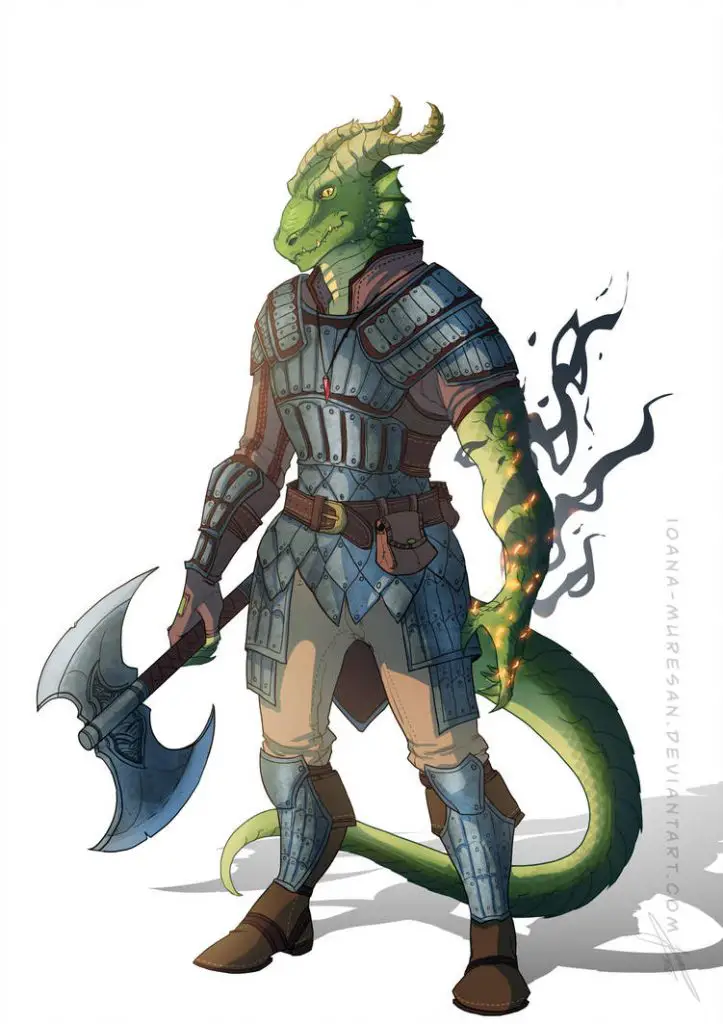
With Strength, Constitution, and Dexterity as their main stats, Barbarians blend well with physical classes. Anything that synergizes with Rage is a prime option.
See our in-depth Barbarian Multiclass analysis here.
Art by Ioana-Muresan, CC License
Things to consider:
- A main feature of Barbarians is Unarmored Defense, so armor proficiencies matter little.
- When raging, a Barbarian cannot cast or concentrate on spells.
- Level-20 Barbarians increase their Strength and Constitution maximum scores to 24. Is this something you’re willing to sacrifice for a multiclass that can’t be achieved some other way?
Compatible Barbarian Multiclass Concepts:
Barbarian/Fighter
Focusing on Strength, a Barbarian/Fighter gains a Fighting Style, Action Surge, a potential to increase crits (especially with Reckless Attack), and possible battle maneuvers. We recommend taking 1-3 levels in Fighter, but definitely not as many as 5, as Extra Attacks don’t stack.
- If you choose to take three levels in Fighter, Champion is a great archetype for increasing the probability of critical hits. A Barbarian who is Reckless Attacking has advantage, and a Champion can crit on a 19 or a 20. You’ll be increasing your probability of a crit immensely.
- With Path of the Berserker, a Barbarian can make a single melee weapon attack as a bonus action each turn. Add in Extra Attack, and the Champion Fighter archetype, and the number of crits a character makes should skyrocket.
- Conversely, choose the Fighter archetype Battle Master and gain extra maneuverability in battle.
Barbarian/Rogue
Adding a few levels of Rogue can beef any Barbarian build. With Expertise, an additional skill, and (if taking two levels) Cunning Action, this is a solid combination. Plus, a Barbarian gains advantage while Reckless Attacking, which gives him automatic Sneak Attack while using a finesse weapon, even while using Strength. For more ideas on how to be a rapier-wielding Barbarian, see our article here.
- We don’t recommend taking more than two levels in Rogue, as none of the archetypes, except maybe Scout, really add much to a Barbarian.
- Note that Sneak Attack won’t be a ton of extra damage, as you’re just taking a few levels in Rogue.
Notable Barbarian Multiclasses:
Barbarian/Bard:
To make this multiclass work, forego damage-based Bard spells and focus on utility spells that can be cast out of battle. This build is useful for improving grappling and athletics abilities with Jack of All Trades (level 2) and Expertise (level 3).
- Take 3 levels in Bard for the College of Swords (Blade Bard) for extra damage.
Barbarian/Cleric:
Clerics have useful Domain abilities that can be used while raging, and healing can be used outside of battle.
- Death Domain adds additional damage once per rest with a melee attack at level two.
- Strength Domain gives you a Druid cantrip and a +10 bonus to an attack roll, ability check, or saving throw, once per rest.
- War Domain allows you to make an additional weapon attack as a bonus action a number of times equal to your Wisdom modifier and gives you a +10 bonus to an attack roll once per rest.
- Arcana Domain combined with the Ancestral Guardian Barbarian totem can produce an interesting Oracle-style Necromancer.
Barbarian/Druid:
To best utilize this multiclass, take at least 3 levels in Druid.
- Druids who choose Circle of the Moon gain the ability to Wild Shape as a bonus action while in a rage. Be sure to choose a beast that uses Strength in its attack in order to gain the rage damage bonus.
- Choose the Bear Path of the Totem Warrior to become resistant to all but psychic damage, even while in Wild Shape, and expend your spell slots as a bonus action to heal yourself (Circle of the Moon), to keep the Wild Shape party going. Since you can’t cast while raging or in Wild Shape anyway, this is a great compromise.
- If you wish to focus on the Druid side of this build, see the Druid/Barbarian section of this article
Bard – D&D 5e Multiclassing
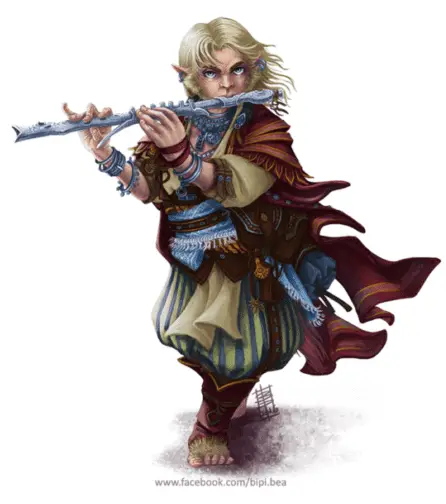
Bard is a pretty versatile core class. Like many other spellcasting classes, Bards use Charisma as their primary stat. Classes that also utilize Charisma are prime candidates to multiclass with Bard. Plus, Bards don’t have many awesome abilities at high levels, so taking a few levels in anything is worthwhile.
Bard by bipicado, CC License
Things to consider:
- Full spellcasters will usually take a hit when multiclassing with other full spellcasters, as they will be unable to reach all high level spells.
- Utilize that high Charisma of a Bard to multiclass with another high-Charisma class.
- Bards aren’t really fighters—they are more utility-based characters, so focus on multiclasses that give more utility (with one exception: a Paladin multiclass).
Compatible Bard Multiclasses:
Bard/Paladin:
If you want to be a fighting Bard, this multiclass is probably your best option, as both Bards and Paladins utilize high Charisma. With the addition of a Fighting Style and Smiting at Paladin level two, Bard/Paladins benefit from a Bard’s higher spell slots: the higher the spell slot expended, the more Smiting damage.
- You could choose Paladin as your core class, but Bards at level 10 and 14 get magical secrets to learn 2 highest spells from any class. Thus, it would be more beneficial to use Bard as your core class, as you can get two high-level Paladin spells that would not be available to Paladins who multiclass with Bard.
- All Paladin archetypes mesh well with Bard except Paladin of Ancients, which is only useful if you take 6 levels of Paladin. This is not a great tradeoff.
- Additionally, while taking 5 levels in Paladin gives you Extra Attack, Bard’s College of Valor can give you the extra attack instead.
- Try to get high Bard spell slots by taking as many levels in Bard as you can in order to deal maximum damage from Smite.
Bard/Cleric:
As full spellcasters, Bards have a great advantage with their spells already. By adding Cleric, a character could have some extra spells prepared. You could also add medium or heavy armor proficiencies, depending on the Cleric’s Domain. We recommend choosing utility/buff Cleric spells that do not rely on Wisdom modifiers.
- Life Domain gives a Bard/Cleric heavy armor proficiencies and enhance healing spells. You will need Strength 13 to wear heavy armor.
- Nature Domain could be thematically cool, as a character will get a Druid cantrip and heavy armor proficiencies (13 Strength required to wear). One could also charm animals in a Snow White-fashion based on Wisdom (if 2 levels are taken).
- Arcana Domain is useful for Bards, but you wouldn’t get armor proficiency. With this domain, you’ll get 2 cantrips and the arcana proficiency. With this, you could always have detect magic prepared.
Bard/Fighter:
This is a clever multiclass with nice benefits. A Bard who chooses College of Valor will get armor proficiencies, but a Bard who multiclasses one level with Fighter will get these benefits all the same. Then, the Bard/Fighter could choose a much more beneficial College for greater utility.
Notable Bard Multiclass:
Bard/Rogue:
Because a Rogue and a Bard both gain Expertise, a character could have up to 8 Expertise skills (if you take 6 levels of Rogue). Additionally, Cunning Action is useful for improved mobility. Note here that Sneak Attack doesn’t really do enough damage to matter with a class like Bard that should focus less on damage.
- At 3 levels in Rogue, a Bard/Rogue can choose the Arcane Trickster archetype, which gives the character additional spells, though they use Intelligence instead of Charisma. As an Arcane Trickster, a Bard/Rogue will gain a suped-up Mage Hand.
- A Scout archetype gives a Bard/Rogue double proficiency on Nature and Survival checks at 3rd level, which is essentially the same as gaining Expertise under a different name. Remember, you only add extra proficiency once, so the ‘Survivalist’ feature does not stack with Expertise.
Cleric – D&D 5e Multiclassing
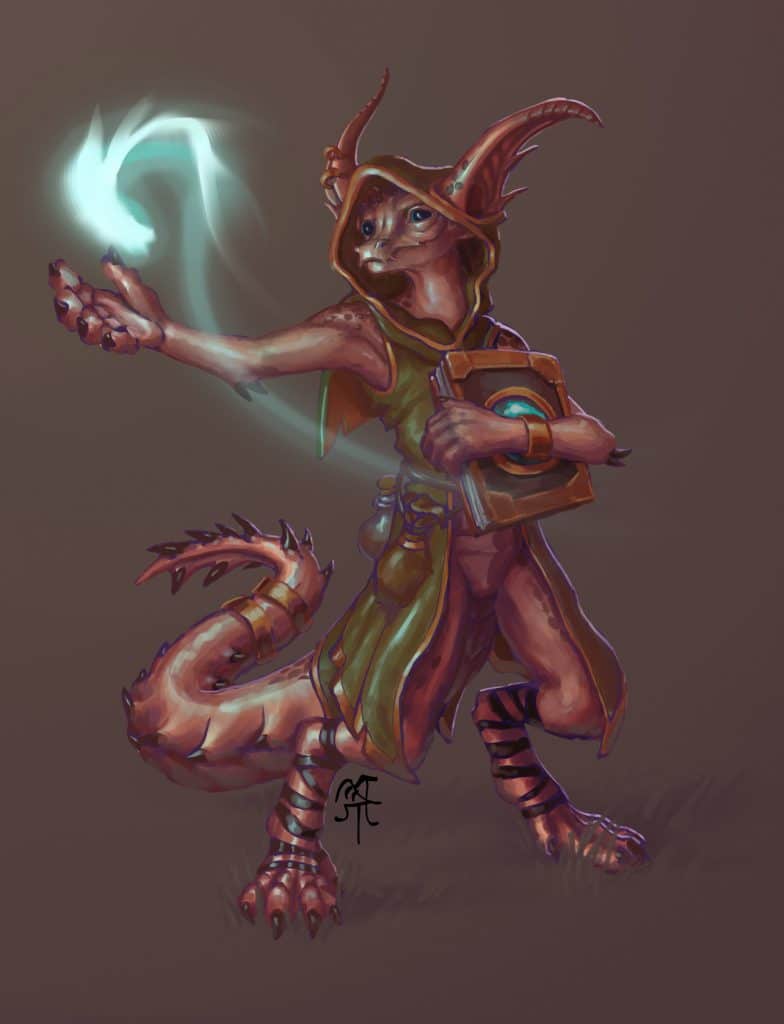
In our opinion, Clerics should just go full Cleric. Clerics have great high-level abilities, and they don’t need to learn spells, just prepare them. With the right Domain, a Cleric will gain heavy armor proficiencies. Additionally, Clerics get a multitude of abilities with Domains and Channel Divinities. You won’t find too many power builds with Cleric as the core class.
For a more in-depth analysis, see our Cleric Multiclass Guide.
Art by Dragon7350, CC License
Things to Consider:
- Most Clerics stay out of the melee fights, but if you want a specific Cleric style, like War Cleric, you will find that Cleric/Paladin is your best option.
- We recommend taking no more than two levels of a multiclass with Cleric, as a Cleric gains three uses of Channel Divinity per rest at level 18, which is an invaluable addition.
Compatible Cleric Multiclass
Cleric/Paladin:
Gaining a Fighting Style and Smite, a Cleric/Paladin gains more martial abilities and attack damage. If a player chooses to take multiple levels in Paladin, his character will gain Extra Attack at level 5, but this risks gaining high-level Cleric spells and abilities.
Cleric/Wizard:
Wizards can dip one or two levels into Cleric since a handful of Cleric subclasses receive heavy armor proficiency as a Domain feature at level one. The Wizard also receives excellent Cleric spells of first level, like Bless and Healing Word.
Druid – D&D 5e Multiclassing
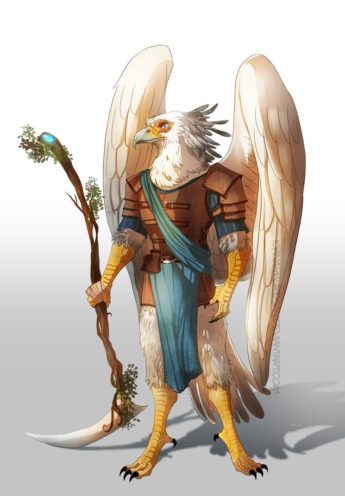
Druids are a versatile core class based on what team role your character will fill: healer, tank, damage-dealer, support, etc. A Druid can mix with many classes adequately when she chooses efficient spells to aid his focus.
Read our in-depth Druid Multiclass Analysis here.
Aarakocra Druid by Ioana-Muresan, CC License
Things to Consider:
- A Druid uses Wisdom to spellcast, so combining with other spellcasters that use Charisma can be a waste of stats.
- At Level 20, Druids can use Wild Shape unlimitedly, so think carefully about multiclassing and missing out on this ability!
- Druids only wear light or medium armor, which can’t be made of metal, so you won’t multiclass for armor proficiencies.
Compatible Druid Multiclass:
Druid/Barbarian:
This is by far the most effective Druid multiclass. Dipping even one level into Barbarian will give you Rage and Unarmored Defense. This will permit you a higher armor class than leather armor, which a Druid typically wears, and the ability to rage in beast form, giving you extra damage with Strength attacks, advantage on Strength checks and saving throws, and extra resistances.
- Choose Circle of the Moon archetype to wild shape as a bonus action, allowing you to keep your rage going.
- Taking three levels in Barbarian and choosing the Bear Path of the Totem Warrior will grant you resistance to all damage types except psychic, and you can heal yourself by expending spell slots as a bonus action (if you are Circle of the Moon).
Druid/Cleric:
A great natural healer. Taking two levels in Cleric will give your Druid character a Divine Domain and a Channel Divinity, which can add some cool abilities and access to additional spells.
- Choose the Life Domain to gain additional healing per spell (2 + spell level), which means Goodberries restore 4 instead of 1 hit point (a total gain of 30 hit points for a 1st level spell).
Notable Druid Multiclasses:
Druid/Fighter:
A single-level dip in Fighter will provide a Druid with a Fighting Style and Action Surge.
- Armor proficiencies don’t help Druids very much, but one particular Fighting Style available is Mariner (UA), which will give a Druid a swimming speed, a climbing speed, AND a +1 bonus to AC.
- Action Surge is helpful for any class, but for a spellcaster, a Druid can cast two non-bonus action spells in one turn. And a character regains his use of Action Surge after only a short rest.
- There are not many Fighter Archetypes that mesh well with Druids, unfortunately. A Druid shines best when he focuses on utility spells above damage output or weapon attacks. While there are many spells that deal sufficient damage, there are more Druid Utility spells that rock. So a Druid that wants to gain a Fighter Archetype should focus on one that provides additional utility, especially to spellcasting.
- Scout (UA) is possibly the best Fighter archetype to combine with Druid, as a character will gain proficiencies in three new skills and superiority dice bonuses for skill checks and armor class.
Druid/Monk:
Taking one level in Monk will give a Druid extra AC with Unarmored Defense (AC = 10 + Dex + Wis, which is great for Druids, who use Wisdom for spellcasting). Taking more levels in Monk can provide extra utility like speed and dodging/disengaging/dashing, but the tradeoff is fewer Druid spell slots. For this build, it is better if you’re more Druid than Monk.
- Check out our fun Druid/Monk multiclass, Monkey Fist.
Druid/Ranger:
For a player who wants to be an effective weapon-wielding Druid, the Druid/Ranger multiclass is probably the best option. As a half-caster, Rangers will augment a Druid’s spellcasting with additional spells (starting at level 2). At first level, a Ranger can choose a favored enemy against which he can track better. With Natural Explorer, he gains a favored terrain; and at second level, a Ranger gains a Fighting Style. This can give bonuses to ranged weapon attacks (Archery), gain a swimming and climbing speed, and increase AC (Mariner, UA), or remove disadvantage for close-quarters shooting while giving a +1 bonus to attack rolls (Close Quarters Shooter, UA).
A Druid/Ranger that desires Extra Attack will take five levels in Ranger. Thus, the character must find an archetype that synergizes with Druid.
- Beast Master will give you a companion to control on your turn. You command actions such as Attack, Dash, Disengage, Dodge, or Help. At level 5 Ranger, you also get to attack in addition to your beast.
- Hunter will give a Ranger extra abilities with attacking, such as damage bonus or an additional attack.
A Druid/Ranger should focus his attention on a Druid Circle and spells that augment weapon fighting or increase utility, so the Circle of the Moon is out of the running.
- Circle of the Land returns spell slots and provides new spells like Misty Step, Silence, Spider Climb, and more. At Druid level six, difficult terrain costs no extra movement, which can be helpful for a ranger who fights at a distance and has to close that distance fast.
- Circle of the Shepherd (Xanathar) allows a Druid to summon spirit auras that give advantage on attack rolls, along with bonuses to summoned creatures.
- Here are three articles on Druid spells that greatly increase utility: Part 1 | Part 2 | Part 3
Fighter – D&D 5e Multiclassing
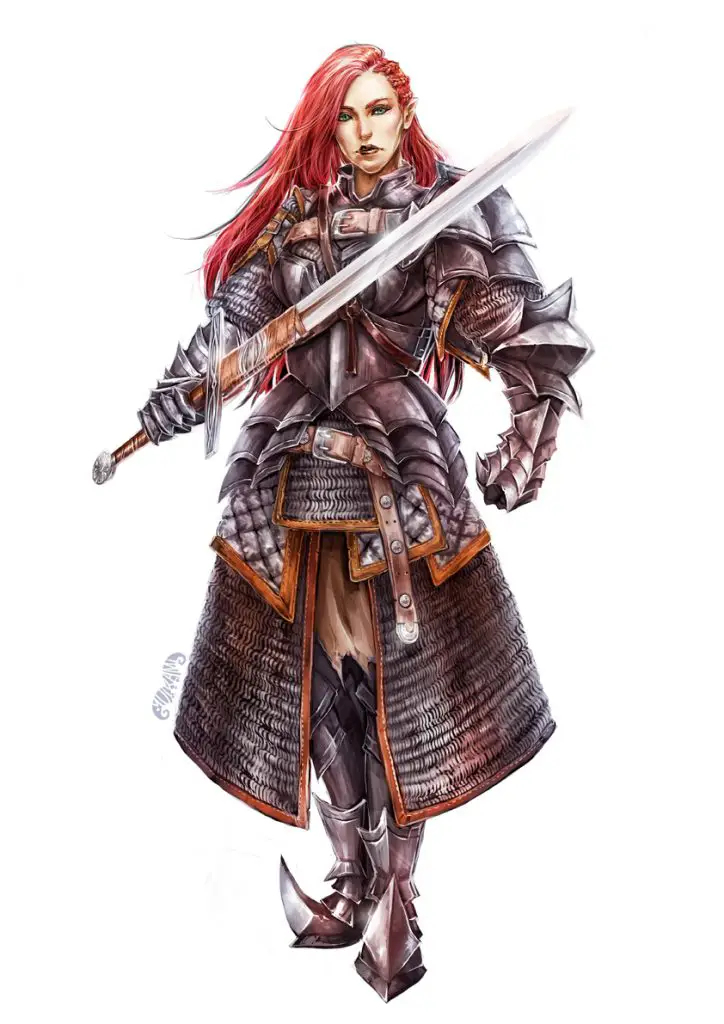
Fighters may benefit greatly from a few levels in another class. Requiring a 13 minimum in Strength or Dexterity to multiclass, this class pairs well with Rogue and Barbarian, as well as Ranger and Warlock.
See our Fighter Multiclass Guide.
Art by yuikami-da, CC License
Things to Consider:
- Focusing on physical Strength, Fighters pair well with other physical stats-based classes.
- Extra Attacks don’t stack, so keep your multiclass level low if the other class has this feature.
- Fighters have proficiencies in all armor and often wear heavy armor, but that is not required.
Compatible Fighter Multiclasses:
Fighter/Barbarian:
Probably the most synergetic multiclass for a Fighter, dipping a level in Barbarian as a Fighter will give Rage abilities, which give advantage to Strength checks and saving throws, damage resistances, and increases damage. A Fighter/Barbarian will not utilize his Heavy Armor proficiencies, as one cannot rage in Heavy Armor, but that is made up for with Unarmored Defense, which allows a character to add his Constitution modifier to his AC.
Taking a second level will add Reckless Attack, giving a character advantage on all Strength-based melee weapon attacks, as well as Danger Sense, where a character has advantage on Dexterity saving throws against attacks that can be seen.
- Take advantage of the Reckless Attack by choosing the Fighter archetype Champion, which scores a critical hit on a weapon attack roll of 19 or 20, increasing the probability for a critical hit.
Fighter/Rogue:
With the addition of a skill proficiency, Expertise, and Sneak Attack, a Fighter/Rogue is a winning multiclass. Taking expertise in athletics, and gaining Cunning Action at level two (dash, disengage, or hide as a bonus action) will help a fighter hone his grappling maneuverability. Also, being proficient in Thieves Tools is always helpful. Don’t count on Sneak Attack adding too much damage, as it’ll be low as a low-level Rogue.
See our Ultimate 5e Rogue Fighter Multiclass Guide for our analysis on this multiclass combination.
I would argue that a player shouldn’t take more than two or three levels in Rogue when multiclassing with a Fighter, as he’ll miss out too much on awesome high-level Fighter abilities. If you choose to go to level three, here are two opportune Rogue archetypes that mesh well with Fighter:
- Assassin: gain advantage on attack rolls against a creature that hasn’t taken a turn yet. Also, any hit you score against a creature that is surprised is a crit. Recall that at level 5, Fighters gain Extra Attack, which means more hits with advantage. Combine this with the Alert feat (+5 to initiative) to ensure success! See this Arcane Archer Assassin build.
- Swashbuckler: Prevent creatures from having opportunity attack against you and gain Sneak Attack when you and your foe are secluded.
Notable Fighter Multiclasses:
Fighter/Ranger:
Become a versatile Fighter with this combination. Choose a favored enemy, gain advantages on difficult terrain, and choose an additional Fighting Style at level two to become an adept fighter and a natural party leader. With the addition of Hunter’s Mark at level two, no enemy can easily escape you.
You basically can’t go wrong with any archetype. Just choose what style of fighting you want to achieve, and you’ll find a great combination.
See our Arcane Archer/Hexblade multiclass “Hexarcher” here.
Fighter/Warlock:
Thematically, this is a very cool multiclass. Gain some impressive Invocations to beef up your utility or weapon damage, and score some wicked Patron abilities.
- Despite the fun build, this can be a weak multiclass, as some of the Pacts do not mesh well or are redundant with Fighter abilities.
- However, combine this multiclass with a few more classes and build a powerful death-dealer.
Monk – D&D 5e Multiclassing
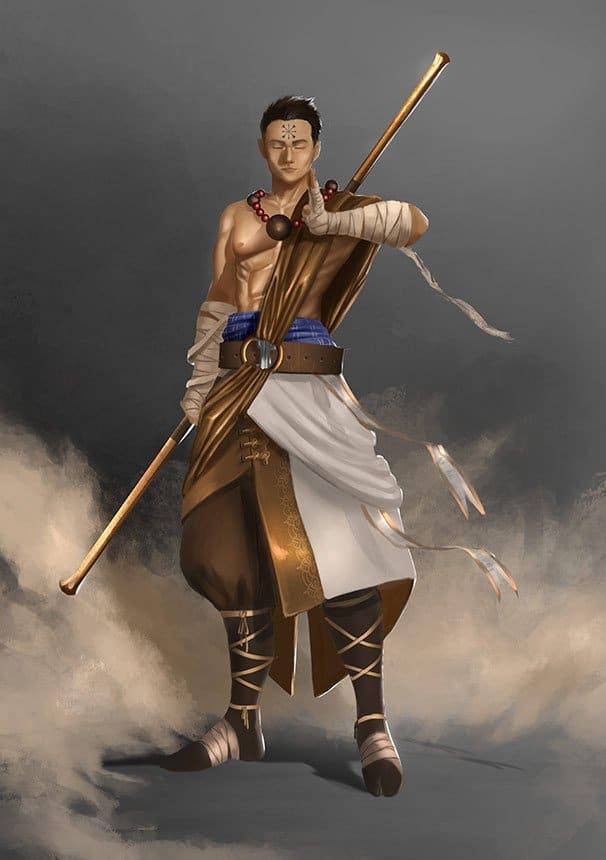
Like Cleric, we recommend building straight Monk for newer players. With an incredible reach of abilities and skills, Monks do not benefit much from an addition of another class. If you do want to multiclass, keep in mind that Monks already have a variety of options for their actions and bonus actions. Multiclassing can be rewarding for Monks who are mindful of their already-crowded options.
Art by SurugaMonkey, CC License
Things to Consider:
- Monks get a high quantity of attacks. If you multiclass, focus on abilities to beef attacks.
- Monks have Unarmored Defense, so armor proficiency does little for a Monk.
Compatible Monk Multiclasses:
Monk/Ranger:
To gain the most from your multiple attacks, a Ranger’s Hunter’s Mark will add 1D6 to each of a Monk’s Fury of Blows. However, instead of multiclassing, you could choose the Magic Initiate feat to gain the Warlock spell Hex and gain the same 1d6 damage boost without compromising a level in Monk.
Monk/Rogue:
Two levels of Rogue will give you Cunning Action; this will save you ki points for disengaging and dashing because Rogues can do some of these usually-ki-expending actions as a free bonus action. Rogues will also get Expertise for stealth bonuses to Shadow Monks. This is a great example of synergy that enhances a Monk’s abilities and ki conservation without overcrowding a character’s options.
Paladin – D&D 5e Multiclassing
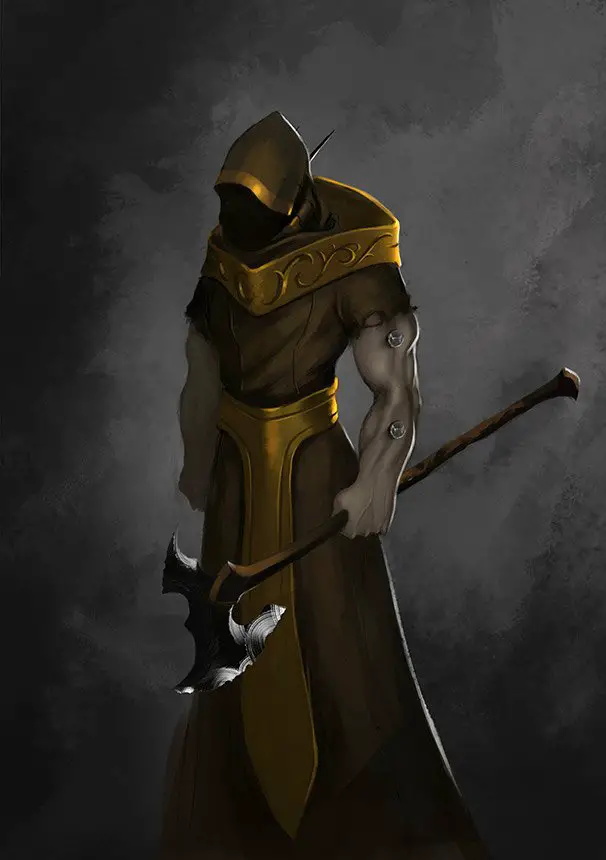
Some of the biggest min/max builds in Dungeons and Dragons involve Paladins who dip into other classes. Paladins can multiclass into anything to gain more spell slots and abilities. Our caution: at what point are you no longer a Paladin? Think more about your character background with this multiclass and less about how much damage output you can achieve.
Art by SurugaMonkey, CC License
Things to Consider:
- Paladins utilize Charisma.
- Theyy are half spellcasters and could benefit from the addition of full spellcasters.
- Paladins have more prerequisites for multiclassing: Strength 13 and Charisma 13, plus whatever stat they need to meet with their new class.
- Divine Smite benefits from higher-level spell slots, but you must use them wisely.
Compatible Paladin Multiclasses:
Paladin/Sorcerer:
With the addition of a Sorcerous Origin, Metamagic, and full spellcasting, this is a powerful build. Like Paladins, Sorcerers focus on Charisma, which means compatible stats for spellcasting.
- We recommend taking at least three levels of Sorcerer to gain the “Quickened Spell” Metamagic option, which will allow a Paladin to attack AND cast a spell as a bonus action.
- Add additional damage for Divine Smite using higher spell slots from the Sorcerer addition.
- You will also want to take at least three levels in Sorcerer in order to gain second-level spells. As written by Gastronomie on Giant in the Playground, a Sorcerer can gain the second-level spell Hold Person and cast it as a bonus action with Quickened Spell. If the spell succeeds, the target is paralyzed, which means any melee weapon hit is an automatic critical hit. Then, with his action, a Paladin/Sorcerer can make a melee weapon attack and auto-crit. Add in Smite, and this is an incredible amount of damage.
Paladin/Warlock:
With individual spell slots per class, and utilizing Charisma fully, a Paladin/Warlock is a great multiclass option that could provide for some interesting backstory and character development. Focus on spellcasting abilities and Invocations that supplement your melee attacks.
- Warlocks are unique in that their spell slots return after only a short rest. Paladins who require spell slots for Smiting are at a huge advantage by gaining a few Warlock spell slots.
- Paladins could benefit from Warlock’s Invocations that provide ranged attacks, but other Invocations could provide much more enticing utility, in and out of battle.
- Many Warlock spells do not require concentration, such as Mirror Image, Armor of Agathys, or Arms of Hadar. These can buff your Paladin/Warlock in battle significantly without compromising utility.
See our powerful Aasimar Paladin/Warlock build (with a dash of Rogue)
Notable Paladin Multiclasses
Paladin/Bard:
Also utilizing Charisma for spellcasting, a full-casting Bard is a great class to add into a Paladin build. Gaining higher-level spell slots to expend on Smite and skills such as Jack of All Trades, you really can’t go wrong with a Paladin/Bard. Choose a Bardic college at level three to increase damage output, utility, or the appearance of an honorable leader.
- College of Lore provides three additional skills and the ability to negate a foe’s damage dealt or skill check.
- Satire (UA) gives many benefits that a Rogue would grant, such as Thieve’s Tools proficiencies and Cunning Action, as well as a climbing speed and reduced fall damage.
- College of Swords provides additional damage and attack utility.
- The College of Whispers deals psychic damage with a weapon attack and helps you to frighten a creature.
Ranger – D&D 5e Multiclassing
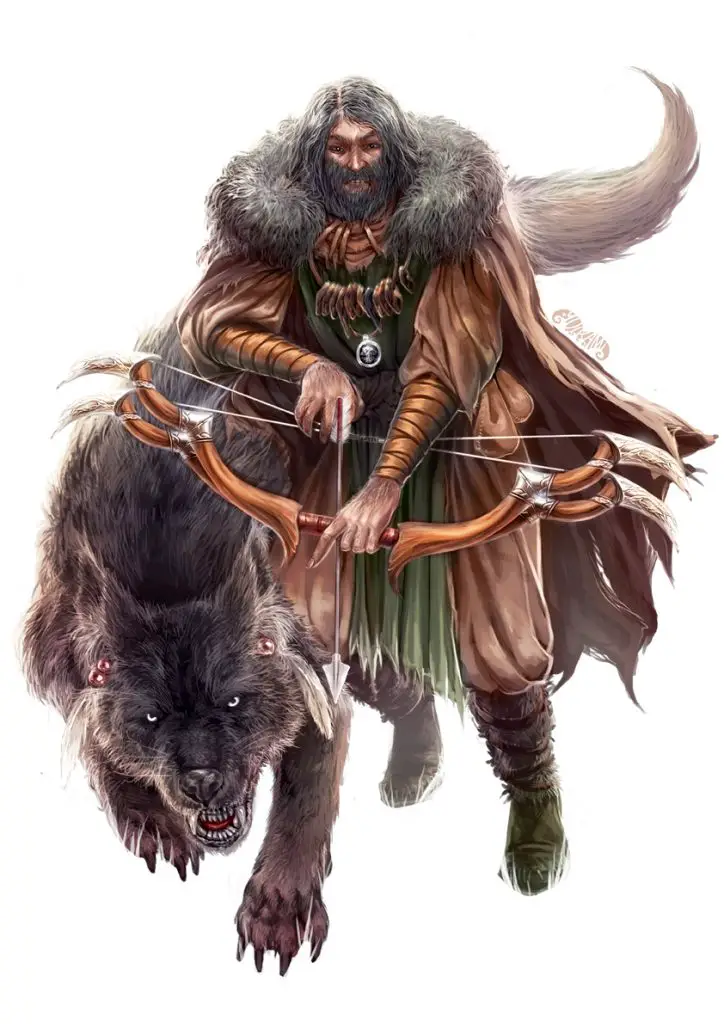
The Ranger is a functional class that has pretty solid utility while still open to diverse development with the right multiclass. On their own, Rangers can be regrettably one-dimensional, but with the addition of the right skills, they can really shine.
Read our in-depth Ranger Multiclass Guide here.
Art by yuikami-da, CC License
Things to Consider:
- Rangers multiclassing have quite a few prerequisites: they need Dexterity 13, Wisdom 13, and to meet whatever stat the new class requires.
- Wisdom for spellcasting.
- Rangers are half spellcasters.
- Hunter’s Mark is very useful and applied to all attacks. Focus on a multiclass that grants multiple attacks.
Read our article dedicated to Ranger multiclassing best practices and cool character concepts.
Compatible Ranger Multiclasses:
Ranger/Rogue:
Rogue and Ranger are very compatible with Dexterity as the main stat.
- Taking three levels in Rogue, a character can choose the Rogue Scout archetype. This will enhance any Ranger’s monster-hunting utility.
Ranger/Fighter:
With the addition of Action Surge and a supplementary Fighting Style, a Ranger/Fighter will gain an additional action per rest, allowing Hunter’s Mark to rack up, and possible extra damage or AC boost. Ranger/Fighters will also gain proficiency in Heavy Armor, which can be beneficial.
Ranger/Paladin:
This can be a powerful build. Use your bonus action to dual wield, utilizing Hunter’s Mark more effectively. You’ll use two light melee weapons and get two uses of Hunter’s Mark per turn. Stack this with a Ranger’s Extra Attack, and you’ve got 2x attacks per turn. Then Smite!
See our Ranger Paladin Multiclass Analysis article for our take on which archetypes and Oaths blend best.
Ranger/Cleric:
With the addition of spells, heavy armor proficiency, and some cool Domain abilities, adding in a few levels of Cleric to a Ranger can only help.
Notable Ranger Multiclasses:
Ranger/Warlock:
There are many directions you could go with this, but the most impactful one would be a Hexblade Pact. This build pays off after a few rounds, as the following abilities take some actions and bonus actions to set up.
- With the Hexblade Pact, for one minute, the Hexblade’s Curse will add your proficiency bonus to weapon damage. Also, critical hit at 19 or 20. Combine this with Hunter’s Mark and Extra Attack for great damage.
- Additional Invocations can increase utility or damage and provide unique character development.
See our magic-based archer multiclass “Hexarcher” here.
Rogue – D&D 5e Multiclassing
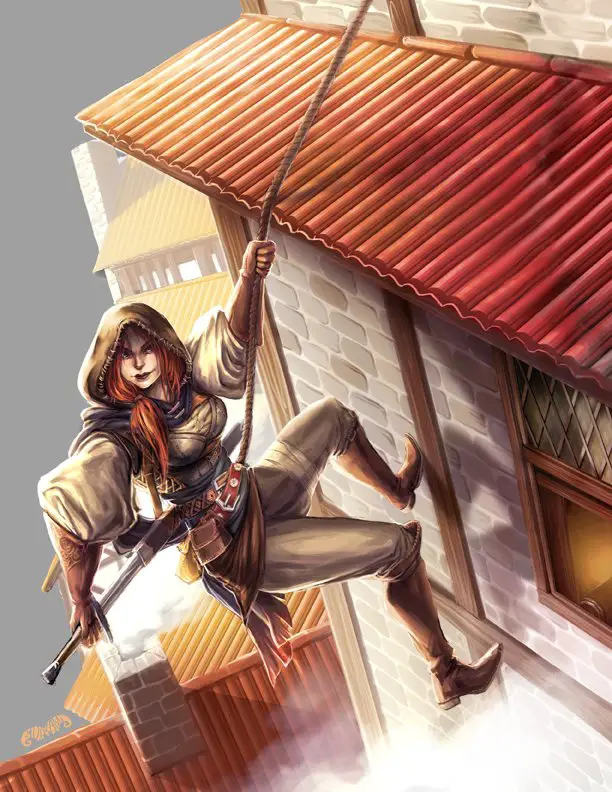
Rogues are versatile and combine well with just about any other class. However, while Rogues can gain useful abilities through multiclassing, Rogues generally do well on their own. Take note of what you’ll miss out on by multiclassing before you take the plunge.
Take a deeper plunge into multiclassing Rogues in this article.
Art by yuikami-da, CC License
Things to Consider:
- The more levels of Rogue you have, the more Sneak Attack damage you’ll deal.
- Rogues get many skills and Expertise in skills, which still focusing on damage output. Let your multiclass focus on damage output as well, or ways that you can bolster your damage.
- Rogues only gain Sneak Attack when they have advantage or a flanking friend. Some multiclasses will help you gain advantage without sacrificing too many levels of Rogue or other Rogue qualities.
Compatible Rogue Multiclasses:
Rogue/Fighter:
Gain a second Fighting Style, an Action Surge, and, if you take three levels, a helpful archetype. Take five levels for an Extra Attack and an additional ability score improvement, but risk dampening your Sneak Attack. Armor proficiencies may or may not help here, as it is sometimes disadvantageous to stealth in medium armor.
See our Ultimate 5e Rogue Fighter Multiclass Guide for an in-depth analysis of how Rogue and Fighter synergize.
- Take three levels of Fighter and choose the Battle Master archetype. Feinting will give you advantage as a bonus action against a foe with an addition of 1d8 damage. Riposte will allow you to attack a foe that misses you outside of your turn, allowing you to add your Sneak Attack and the extra 1d8 damage.
- Pair Action Surge with the Assassin archetype for major damage output.
- See our Rogue/Fighter build here, in which we analyze the maximum damage on a first turn at level 16 (spoiler alert, it’s over 250).
Notable Rogue Multiclasses:
Rogue/Bard:
Both classes gain Expertise. If you want a character that has many skill proficiencies and high rolls with those skills, I highly recommend a Rogue/Bard multiclass. Swashbuckler Rogues will benefit from the Charisma investment that comes with Bard levels. Arcane Trickster Rogues will gain more spells and spell slots thanks to the full spellcaster levels of the Bard.
These two classes share many thematic similarities that lend well to roleplaying choices. There are many subclass archetypes that can lend well to one another. I recommend keeping an eye on which subclasses of Bard will not use bonus actions too often because Rogues have the Cunning Action feature that uses their bonus action. In this context, the Bardic College of Swords (XgtE) and the College of Valor (PHB) look to be strong multiclasses for any Rogue.
I wish to note that we previously suggested that Reliable Talent could stack with Jack of All Trades, but it has been clarified in Sage Advice’s 2019 Compendium that this combination will not work.
Rogue/Cleric:
This is multiclass could maximize your character.
- Take the Cleric Grave Domain to get Channel Divinity in order to mark someone so that they take double damage. As a Rogue assassin, you could potentially do up to hundreds of damage.
- Example: see our Assassin of the Grave build.
Sorcerer – D&D 5e Multiclassing
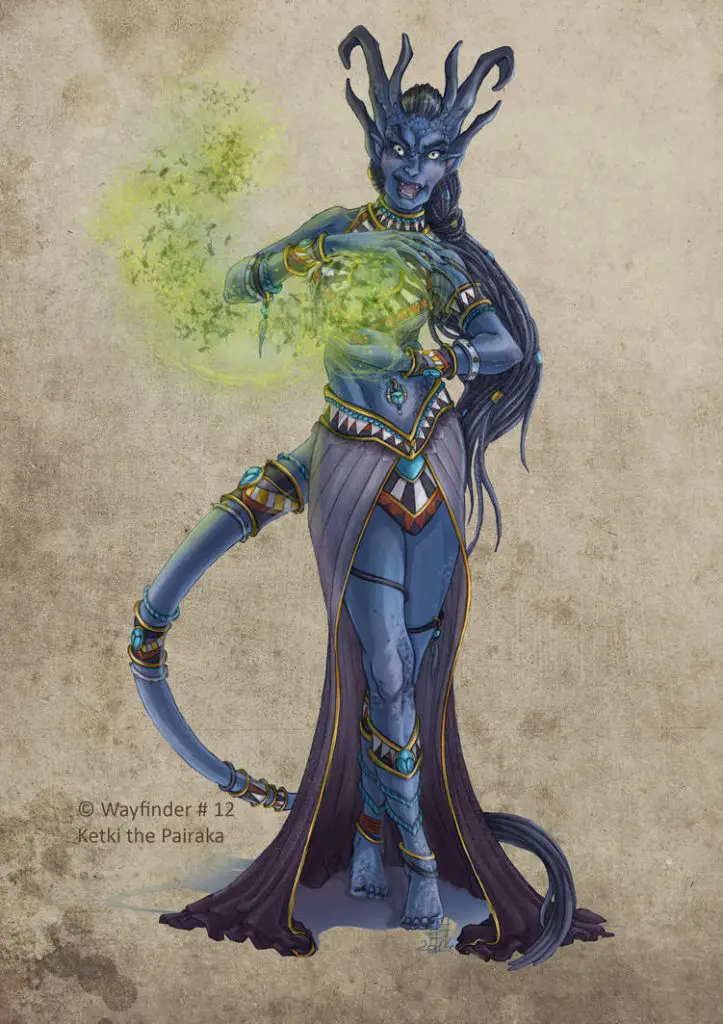
Similar to but less damage-dealing than Wizards, Sorcerers are full spellcasters with little defense (no armor proficiencies). With the addition of sorcery points and Metamagic, Sorcerers have a few Strengths over Wizards to balance out their weaker spellcasting.
Art by BiPiCado, CC License
Things to Consider:
- Sorcerers utilize Charisma for spellcasting and they are full spellcasters.
- Sorcerers start with no armor proficiencies.
- The Sorcerer as a core class seems to shine brightest in a support role. Make this your focus when multiclassing. If you want to be a min/max player, we recommend you find a new core class. Dorgenedge on Reddit makes a great argument for this and how to play a Sorcerer.
- Focus on buffs and aiding your teammates, and you’ll surmount any spellcaster in utility.
Compatible Sorcerer Multiclasses:
Sorcerer/Warlock:
This is a nice combination, as Warlocks regain spell slots on a short rest. Also, both classes use Charisma for spellcasting, and Warlocks come with their own spell slots.
- We recommend taking the Pact of the Tome to learn three additional cantrips from any class’s spell list for free.
- Archfey is a beneficial Patron, and you will gain great utility spells unavailable to Sorcerers, like Faerie Fire and Calm Emotions. Fey Presence is a great way to take enemies out of the battle temporarily.
- Hexblade provides armor proficiencies and a few spells. This is a good compromise for gaining melee abilities in case you’re in a bind.
- The Raven Queen grants access to the Sanctuary spell, which is a great buff for your allies. You will also gain utility through Sentinel Raven.
- Look for Invocations that provide utility or buffs.
Notable Sorcerer Multiclasses:
Sorcerer/Cleric:
Clerics provide armor proficiencies, domain spells, and extra utility. You basically can’t go wrong with a Sorcerer/Cleric combination. However, Clerics utilize Wisdom for spellcasting instead of Charisma, which may weaken your utility slightly.
- Focus on Cleric Domains that provide additional support abilities.
Sorcerer/Fighter:
Taking one or two levels in Fighter is a perfect way to gain defense without compromising too many levels in Sorcerer. Gain Action Surge for the chance to cast an additional non-bonus action spell on a turn, which is imperative when buffing or debuffing in battle.
- We recommend taking fewer than three levels, as there is not really any synergetic Fighter archetype to a Sorcerer.
Sorcerer/Paladin:
This build is powerful when a Paladin is the core class, but, since Paladins are half-spellcasters, this can dampen a Sorcerer’s spellcasting abilities.
- By gaining light and medium armor and shield proficiencies, a Sorcerer/Paladin finds a way to defend himself. Choose the Defense Fighting Style at level 2 to gain even more AC.
- Divine Sense is a nice ability that a Sorcerer wouldn’t get otherwise, as Detect Good and Evil is not among his spell list. Also, this ability utilizes Charisma, which a Sorcerer covets.
- Though Sorcerers often focus on spellcasting, a Sorcerer/Paladin could focus on weapon fighting and choose buff spells. However, at this point, I would recommend using Paladin as your core class and taking a few levels in Sorcerer. See the Paladin section for more details on why this is preferred.
- For a Sorcerer to focus on damage-dealing spells, we recommend taking only one level in Paladin for the proficiencies or finding another way to gain armor proficiencies.
Warlock – D&D 5e Multiclassing
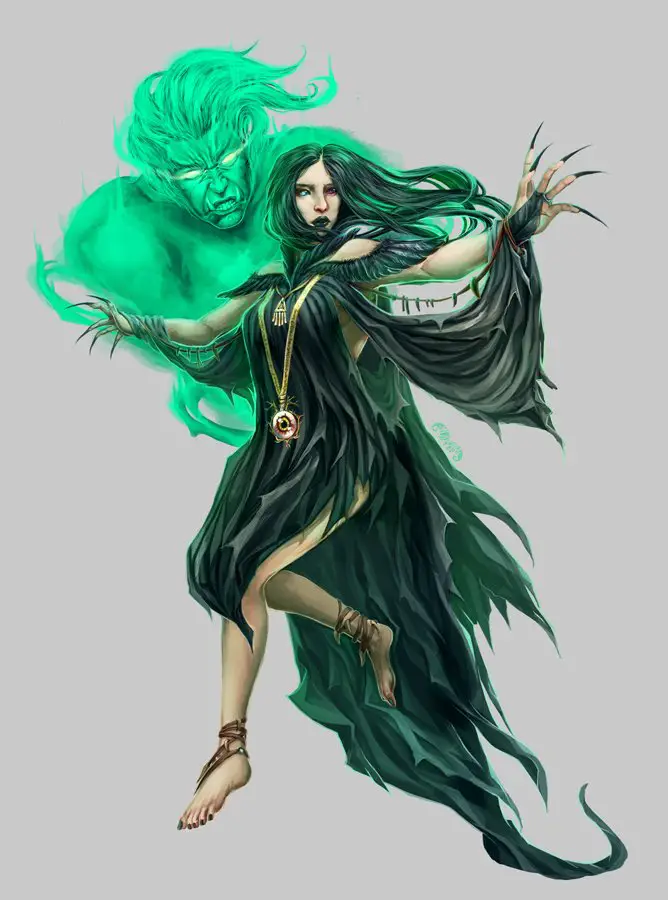
Great damage dealers for melee or ranged attacks while also providing excellent utility with Invocations, a Warlock is a formidable class that could benefit from a few levels of the right multiclass.
Art by yuikami-da, CC License
Things to Consider:
- Warlocks utilize Charisma in spellcasting.
- They have their own set of spell slots when multiclassing with other spellcasters.
- Warlocks are proficient in light armor, but there are some Patrons and Invocations that provide additional armor proficiencies.
Compatible Warlock Multiclasses:
Warlock/Paladin:
With two levels in Paladin, a Warlock will gain armor and shield proficiencies, Divine Sense, a Fighting Style, Lay on Hands, more spellcasting, and Smite.
- Armor and shield proficiencies will help defend your Warlock character.
- Divine Sense allows you to know if unworldly foes are around, which can combine well with the Warlock spell “Protection from Evil and Good.”
- A Fighting Style can help boost AC. You could also take the Close Quarters Shooter to bolster your ranged spell attacks, like Eldridge Blast.
- Lay on Hands won’t provide much healing at such a low Paladin level, but it can help in a bind.
- Recall that Warlocks have special spellcasting rules and get their own spell slots apart from spellcasters they multiclass with. However, you can use those spell slots to cast spells from the other class. This means that you can gain a few Paladin spells and cast them with your Warlock spell slots, up to fifth level. Also, both classes utilize Charisma for spellcasting, so your stats are compatible!
- Smite is key in this build. Smite benefits from high-level spell slots, which we just discussed. Warlocks won’t take a spell slot hit from multiclassing with another spellcaster, so you have plenty of high-level spell slots to use with Smite. Plus, Warlock regain spell slots with a short rest, giving you more uses of Smite than a typical Paladin.
Warlock/Sorcerer:
With the addition of a Sorcerous Origin, Metamagic, and a few supplementary spells at third level, a Warlock/Sorcerer can bolster spells.
- Empowered Spell allows you to reroll damage dice.
- Extended Spell doubles a spell’s duration if it normally lasts one minute or longer, but the extended duration can’t exceed 24 hours.
- Quickened Spell allows you to cast two non-bonus action spells in one turn, provided one spell is a cantrip.
- Subtle Spell allows you to cast a spell without somatic or verbal components.
- Twinned Spell allows you to target more than one creature with a spell.
Notable Warlock Multiclasses: Wizard
Warlock/Barbarian:
Warlocks and Barbarians have some surprising synergetic components.
- Though a Warlock/Barbarian can’t cast a spell in Rage, he can still use non-spell Eldritch Invocations. You won’t get the rage bonus (that’s only for melee attacks), but you will get advantage on Strength checks and saving throws and resistances. Just remember you still have to deal or take damage to keep your rage.
- A Warlock/Barbarian will also gain Unarmored Defense, which could be valuable.
- Warlocks tend to stay out of melee battle, but a Barbarian multiclass could allow you to get right into the thick of it.
Warlock/Fighter:
While this is a good multiclass, The Hexblade Patron provides the same proficiencies while also granting a Charisma modifier bonus to attacks and critical hits on a 19 or 20. However, if you wish to take a different Patron, a Warlock/Fighter multiclass can bolster your defense. Add in a Fighting Style and Action Surge, and you could find yourself with a great multiclass.
- Similar to Wizard, would it be more beneficial to take your first level in Fighter for the weapon, shield, armor and Constitution saving throw proficiencies; extra hit points; and equipment? Warlocks don’t require equipment for spell casting, so you would just be missing out on a few Warlock proficiencies, like saving throws and skills.
Wizard – D&D 5e Multiclassing
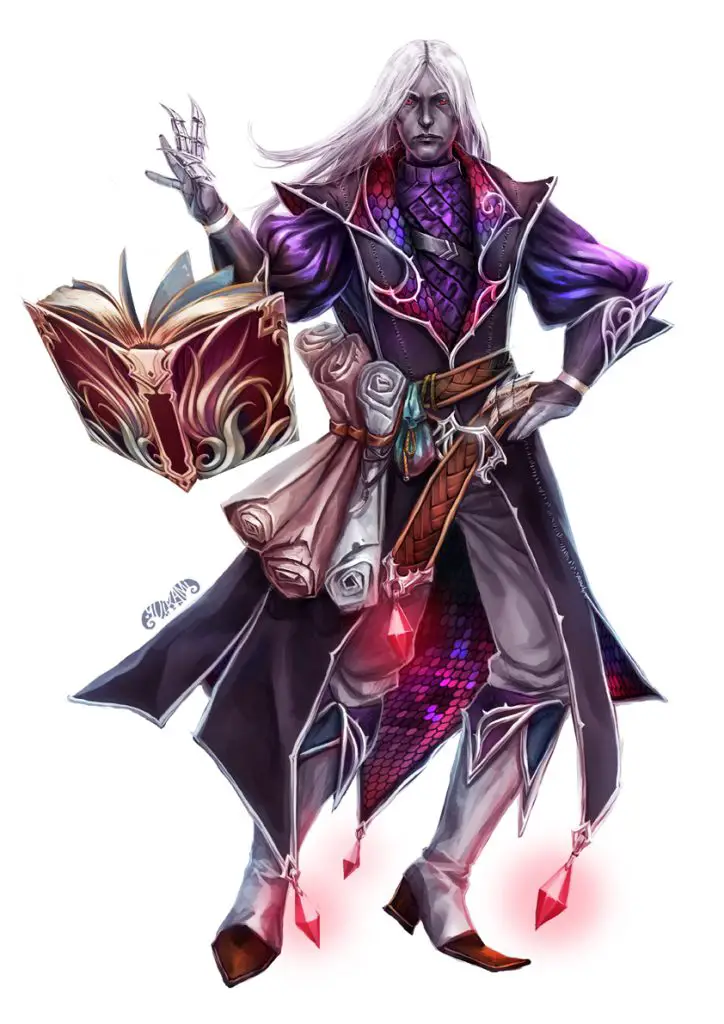
Notably defenseless, Wizards benefit greatly with a few levels of multiclassing that provide extra defense.
For our complete Wizard Multiclass Guide, see our article here.
Art by yuikami-da, CC License
Things to Consider:
- Wizards excel with high level spells, so keep your multiclass low.
- A Wizard’s level 18 ability Spell Mastery is incredible. You don’t want to miss out on it.
Compatible Wizard Multiclasses:
Wizard/Cleric:
Take one or two levels in Cleric to get armor proficiencies.
- One level with the Forge Domain from Xanathar’s Guide to Everything will grant heavy armor proficiencies as well as give a bonus to AC to a suit of armor until the end of your next long rest.
- Life Domain also allows a character to gain heavy armor proficiencies while also boosting healing spells.
- Order Domain gives heavy armor proficiency and allows an ally, when you cast a spell on that ally, to use a reaction to attack a creature that you can see.
- Look for other Cleric domains that provide armor proficiencies.
Wizard/Fighter:
This combination will, again, provide proficiencies with armor, which will help a Wizard defend himself. Another cool feature is the use of Action Surge to cast two spells in a turn, provided neither spell is cast as a bonus action. Plus, a Wizard will gain just a few extra hit points with the Fighter levels she takes.
- One consideration is taking the level of Fighter first, then taking levels in Wizard. Fighters start with more hit points, better defense- and attack-based equipment, Strength and Constitution saving throws, and different skills than a Wizard, though some of them overlap.
- Wizard equipment like a spellbook and a components pouch can be acquired in-game, and starting on a quest to find those things could provide for fun role play.
Notable Wizard Multiclass:
Wizard/Rogue:
Gaining proficiencies in light armor, a Wizard/Rogue will gain a much-needed boost in AC. Plus, additional skills gained are worthwhile: one skill from the Rogue’s skill list, thieves’ tools, Expertise, and, at second level, Cunning Action to help a defenseless Wizard effortlessly flee from foes.
- Additional Wizard/Rogue utility: take the Thief archetype and use Fast Hands to attempt, as a bonus action, to steal an enemy Wizard’s components or spell book to make them essentially useless. Bonus, you keep whatever you take!
Conclusion
Keeping in mind the three main reasons for multiclassing (armor proficiencies, low-level class skills, character development), choosing the right combination is key. Before you multiclass, check with your DM about what level you’re going to reach in your campaign. If you don’t expect to gain those sweet high-level abilities, multiclassing could be a fun and powerful choice that improves your character’s utility and damage.

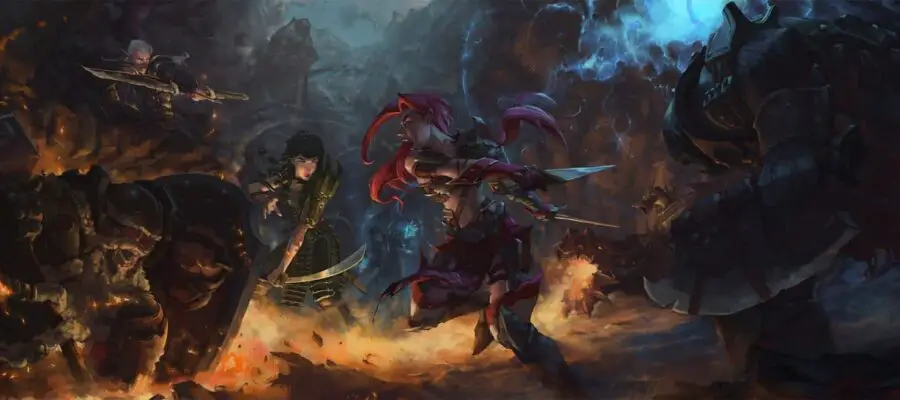



Enjoyed examining this, very good stuff, thanks .
One small little nitpick that stood out to me while reading was that in the Warlock/Sorcerer multiclass you said that with quickened spell you can cast two non-bonus-action spells. This is false because in the base rules you cannot cast two spells in one turn (even if you action surge or use quickened spell). What quickened spell allows you to do is cast both a cantrip and a spell in one turn.
Thanks, kwama_kween! I should have clarified that you can cast two non-bonus action spells in a turn. The Player’s Handbook (pg. 202) only limits spell options when you cast a spell as a bonus action during your turn. So a Fighter using Action Surge could use two actions in that turn, and both of them could be used to cast a spell (as long as the Fighter doesn’t cast a bonus-action spell). This is a commonly misunderstood rule because of the wording, but it’s clear when you read it in the context of its paragraph which is only talking about bonus-action spellcasting.
You can read about this if you look up tweets by Jeremy Crawford (D&D lead game designer) on the subject. Here’s an example of his tweets (he gets questions about this a lot): https://www.sageadvice.eu/2019/08/14/my-friend-got-angry-with-me-saying-i-cant-use-a-spellaction-surgespell-because-you-can-only-cast-one-spell-per-turn/
Thank you for helping keep our content accurate!
I think the Rogue (arcane trickster) and wizard bladesinger combination is interesting too.
Hi Sven! That sounds like a fun combination. What aspects of it do you like best?
Hey Flutes, thanks for the question. So with only a 2 level dip in Wizard Bladesinger as an Arcane Trickster you get access to the wizard spellbook and Bladesong. Note that you must be an elf or half elf unless your DM removes this restriction.
The wizards spellbook increases your number of spells that are ready to cast. The Wizard’s Ritual Spellcasting feature allows you to cast rituals without having them prepared. So you improve the spell casting ability of the rogue considerably.
Bladesong is active for 1 minute and improves your survivability. You get faster, your AC is increased by your intelligence modifier, you have an advantage on acrobatic rolls and get a bonus on your constitution saving throws at the level of your intelligence, so you can better maintain concentrations spells. In combination with for example Shadow Blade this is great.
In addition, you are able to use items which require you to be a wizard.
You get all of this for 1d6 sneak damage less than the singleclass rogue would do. So a good deal.
That makes heaps of sense and sounds like a fun character concept. I will have to try it sometime! Thanks, Sven.
This guide appears to incorrectly imply in places that you gain armor proficiencies from taking multiclass levels in certain classes, which is often not the case. For example, adding fighter levels to a ranger will not give a ranger heavy armor proficiency. You need to take fighter as the core class to get that, and then add ranger levels.
An example of an exception to this is taking War Cleric, which does grant heavy armor proficiency, even if you don’t start out with it.
Thanks Devo, we updated the instance where we implied Fighters give heavy armor. Thanks for helping us keep our content up to date! Please let us know if we missed anything.
Jack of All Trades and Reliable Talent do not interact in the way that you stated.
https://www.sageadvice.eu/2017/10/15/how-would-reliable-talent-work-with-a-roguebard-and-their-jack-of-all-trades/
Hi Waffles,
I thought I responded to you much earlier, sorry. We fixed this oversight. Thank you for linking to the source!
For anyone reading this in 2020 on, please don’t use this “guide” as a basis for making character choices. First, any time an example of a full build comes online at a certain level, you need to realize that you don’t have those features for a majority of the game. Beware any builds that use level 20 characters, for instance, as you will likely only play them in one-shots or with a VERY dedicated group of players. In this guide, the writer references a grave assassin, for instance.
Your decision to multiclass should be based on really one or two decisions. First, do you want end-game abilities in your class? If not, which ones are you willing sacrifice? Second, to what degree are you forcing synergy? By that I mean some classes synergize better because they match attributes. Having a three attribute class is not impossible, players may call you MAD (multi-attribute dependent) and say it’s a bad decision.
If you want to min/max, you WILL have to multi-class at least once depending on the class and synergies you want.
This guide also recommends certain classes should go full build such as cleric and monk. While this is fine in its own right, I disagree with the logic of this recommendation. Monk/Fighter can action surge quivering palm end game and still gain the advantage of increasing action economy and use more ki points before this is possible. Cleric/Druid have stat synergy and increase spell variety, additionally both classes can benefit by relying on WIS with DEX/CON as the next two highest stats. Cleric/Sorc can also do some silly things tempest domain/storm sorc. A channeled divinity lightning bolt at level 7 going to break some fights early, and stays relevant for the entire game. Prior to this, the Cleric/Sorc can be extremely supportive and doesn’t have problems with multiple casting stats. These are just a few examples of end-game goals with strategies on how to play until the huge power spike happens. I just gave you two end-game builds and then provided examples of how they work before coming online.
Furthermore, if you are the min/max player, EVERY SINGLE CLASS benefits by starting the game as second level fighter to gain the benefits of action surge, weapon style, and armor proficiencies before multi-classing. This keeps you alive long enough to multi-class and gives you action surge which is likely the king of all broken abilities.
So what’s the point? Multi-class if you want to. It doesn’t matter in 5e, all of them hold their own. If you have an adversarial DM, or enjoy that kind of play, then min/max away. Point is, have a goal in mind. I don’t believe this article did a good job of explaining this.
Hi Funkmaster,
Thank you for your honest opinion! I think if you review the article again, you’ll find that we agree on a lot of your points. Our aim with this article was to provide considerations for players who are getting started with multiclassing. If you want to check out other articles we’ve written that have more depth for multiclassing concepts we like, we have a few that you could browse (https://www.flutesloot.com/category/player-characters/multiclass/). We’d welcome your feedback on any of those articles as well!
The first article I ever wrote was for Rogue+Cleric multiclass concept that I fell in love with. It has attracted some discussion in the comments from other interested players, and I’ve enjoyed their input as well. (https://www.flutesloot.com/assassin-of-grave-multiclass-combination/)
Have a nice day!
Nothing on Shadow Monk / Rogue? Two levels of rogue for your dash and disengage for free, instead of having to use Ki, as well as being able to stealth better as a Stealth Monk. The Downside? You lose the ability to spend 4 Ki at level 18 to do what you can do for free at level 11. Building straight Monk is fantastic, I’m sure, but they can ABSOLUTELY benefit hugely from 2 or 3 level dips into other classes!
Hi HappyKenkuNoises,
Your idea is excellent. Monks usually have a fatigue on their bonus actions, but their capstone at level 20 isn’t that great. Your point about multiclassing as a Rogue to save on ki points and gain some Rogue utility is a great idea, so we’ve added it to our article in the Monk section. 🙂
“Extended Spell makes a 1 minute spell last 24 hours”
I don’t think this is true. It only doubles the duration of 1m+ spells, to a maximum of 24 hours. Implying that any spell with a duration >12hrs would not be doubled, but rather capped at 24 hrs. But a 1m spell only becomes a 2m spell, and a 10m spell becomes a 20m spell, and so on.
“When you cast a spell that has a duration of 1 minute or longer, you can spend 1 sorcery point to double its duration, to a maximum duration of 24 hours.”
Even if one interpreted it as 1 sorcery point per doubling, which is debatable, it would take 11 sorcery points to make a 1m spell a 24hr spell — you’d need 11 levels of sorcery and a full SP pool to pull it off.
Hi Rooth,
Thank you for the thorough response. You’re correct, and I fixed the article.
Ranger or Druid with 1 level in Life Domain Cleric will give you heavy armor proficiency (for the ranger) and make it so each of your 10 Goodberries will heal 4hp and Healing Spirit will heal 1d6+4hp every round. After a battle, just using a second level spell slot you could heal your whole party an average of 75hp if you have a minute to Conga line through it.
Hi ATinyWaffle,
Healing Spirit used to be an incredibly strong spell, but it was recently nerfed in the Xanathar’s Guide to Everything errata (https://media.wizards.com/2020/dnd/downloads/XGtE-Errata.pdf):
“Healing Spirit (p. 157). The following text has been appended to the second paragraph: ‘The spirit can heal a number of times equal to 1 + your spellcasting ability modifier (minimum of twice). After healing that number of times, the spirit disappears.'”
It’s still an effective spell for a second-level spell slot, but not nearly as broken anymore (or as silly to visualize).
Love all these suggestions! Was thinking it would be fun to try a College of Swords Bard/ Hexblade Warlock using archery and the exceptional level 10 bard’s ability to choose ranger spells. Even more fun with elven accuracy. Crit fish w a Hexbow and Swift arrow (at Swords Bard 10 that’s 4 attacks), pick up greater invisibility to maintain advantage, and use blade flourishes to stay out of melee reach. Not full optimized build but Cha synergy and noticed you don’t need to use melee attacks with blade flourishes
This sounds like a great build! Elven Accuracy is one of Flutes’ top-recommended feats for Elves, and I especially like the tactic with Greater Invisibility. Being totally optimized is not always as important as coming up with an excellent character 🙂
Hi Morris,
Another example of how strong the Hexblade Warlock is for multiclassing. I think you’ll have heaps of fun while dealing oodles of damage.
Core fighter battlemaster with a three lvl dip in sorcerer for origin clockwork soul from (TCE) for the ability to swap spells and the ability to not give creatures advantage or disadvantage to keep the battlefield even. With spells like shield, absorb elements, and now mental barrier from (UA) make you a potent fighter using reactions for action economy. All the while having 6 spell slots and metamagic for quicken spell to make use of extra bonus actions. Pick up fey touched at lvl one using a variant human and war caster at 6th then multiclass at 7 into sorcerer. A battle master with excellent utility in my opinion.
Sounds like a martial character with plenty of options!
Reviewed the builds, and loved them! Let´s see how you guys think about this.
Right now I am building a fighter/necromancer, who is balanced to do meelee damage and use animated undead as army.
Race: High Elf (Dex + Int) or Human.
Stats focus: Dex/Int/Con
Fighter 1 (Defense Style) -> Wizard (Necromancer) 5 -> Fighter 4 (Battle Master) -> Wizard 1 -> Fighter 2 -> Between to add 1 and 1 of each class.
Fighter to begin with better hit points, weapon and armor proficiencies. Use the army of undeads as allies, spells (Lvl 3) to maintain them every 24 hours, and use melee(finesse) & ranged weapons to do damage. Additional spells to control the battefield or self defense. Bonus actions will be used to command the undeads all the time, no exception.
What do you think about it?
That sounds like a fun concept, FunLord! My taste in necromancer would be one that isn’t squishy and can get in the fray. It would be cool to use maneuvers to disarm and enemy while your undead posse takes away the dropped weapons.
Have you considered swapping out Fighter to instead try Artificer Armorer? This would allow you to still get Extra Attack, and you could wear heavy armor without investing in Strength. You’d also keep your spell slot progression a bit since Artificers are half-casters.
Totally, however my DM prefer to play with core content (PHB). Before going to other books, I am trying to make it possible using his rules. Of course, he is willing to allow it if I bring a really good background and well-constructed character.
As a draft, I tried to pull it out firstly with 1 Fighter + 5 Wiz with 15 dex as stat. Equipped medium armor(Breatsplate) + Shield + Defensive style(Fighting style). In the end I got 19 AC. Of course, finesses weapons are added. Just in case, Feat: Defensive Dueilst. and one
I know that this kind of build is not the best considering everything we have, for example Bladesinger. Really loved the concept. So, do you think that this PHB build can be useful for lvl 10-15 combat?
Sounds fun to me! You’ll need to be careful with how you use your reactions for Defensive Duelist since you could potentially use Counterspell, Absorb Elements, or Shield spells (assuming you have them). The AC sounds awesome for a Wizard without any crazy combos; very reasonable. For the sake of exploration, is there a purpose for investing in Dexterity and Dex-based armor instead of Strength and heavy armor? You could get higher AC with heavy armor. I assume it’s because your DM is keeping to the core rules that won’t allow for racial stat bonuses to be used on stats of choice as Tasha’s preaches. 😛
Since you’ll have a single attack per round, Booming Blade will do very well for your attacks.
Thank you for the feedback. I will definitely consider the str stat bonus. The reason I choose Dex is because:
1- Theme. It is a warrior that uses magic. It won´t have enough time to train physically to get all the muscles while train in magic. I believe that roleplaying > be overpowered.
2. Feat Defensive Duelist needs finesse weapon.
3. Medium armor to avoid disadvantege in stealth check.
4. Dex stats give possibility to use melee and ranged weapons,
5. Initiative is important stats for combat. Settle undead army across the map strategically to help other allies is great.
During combat:
– Action: melee or ranged attack. Or use spells to control, get more defense, or help allies.
– Bonus action: Command undeads.
– Reaction: Defensive.
That´s why I had to do so much research and also make sure that this PC has all attack and defense options coming from action or reaction. The only concern at the end of the day is: Will he/she do decent damage/control, and great roleplaying?
Roleplaying isn’t dependent on a character build, so you’re all good there. Do you think it’s improbable to become deadly with a bow while learning magic as opposed to being strong while practicing magic? Some people are born bulky and their diet makes them huge with little training. My advice is to treat roleplaying completely separate from stats, but I know it’s a common practice to intertwine them.
You might find that you focus on cantrips for offense more than bows unless you insist on using ranged weapons. You won’t have Extra Attack, and cantrips will scale.
But like I said, it’s a great character idea and I know you’ll enjoy yourself if your DM isn’t denying you an undead attack squad. Make sure you’ll be around enough humanoids to use your Animate Dead. 🙂
On warlock/fighter, I recommend not going with Hexblade but instead Fiend. The overlap goes away and temp HP for your kills is particularly excellent for melee fighters (plus higher level abilities like the damage resistance are never not going to be helpful). I recommend not going too far into fighter (a 7th level EK by 20th level is about right in my opinion) and I suggest EK (without bothering to raise a decent Int score) to get spells like Absorb Elements, Shield, Magic Missile, Fog Cloud and Sleep that don’t require Int in any way. Plus you get low-level spell slots with which you can spam certain spells that don’t want upcasting. At 7th level you can use Booming Blade with a second attack so you aren’t suffering from one attack per turn.
Other options include Battle Master (as always) or Rune Knight. But really anything can work here.
If you want you can even ake a third class and get some abjuration wizard magic. Your extra pool of HP will make Armour of Agathys very tempting.
You shouldnt leave artificer hanging like that, especially since he works great with most classes and can bring a lot of melee INT builds to life
Hi Samuel,
You’re correct. I added more to the Artificer section this morning. We had previously added the Artificer section quickly when it was released as a class, and we hadn’t been back to update this article. Thank you for the reminder!
We’ll eventually have a multiclass article devoted to the Artificer on the site as we’ve done with several classes so far.
Druid/barbarian can also be extremely effective using the Circle of Spores druid subclass. First round action to Symbiotic entity gets you 4 temp hp/druid level, double the reaction damage for halo of spores (for action economy), give +1d6 necrotic to all melee attacks, and for bonus action rage means all the temp HP counts for double vs pierce/slash/bludgeoning (and against everything but psychic for Bear totem barbarian).
Combine this with polearm master to get the bonus action weapon-butt attack for a second attack on your turn (if you want a spear and shield for extra AC), or add a level of monk for the bonus action martial arts punch as a second attack (and probably a better AC than for constitution for most druids).
The Circle of Spores is an interesting addition to any martial character due to its damage-boosting feature!
I tried this and it worked well, but I had more fun after I decided to get to Bladesinging 6th for the extra attack/cantrip per turn. The loss of sneak attack dice is easily mitigated by cantrip damage scaling, not to mention the other shenanigans that cantrips bring to the table; took Mobile as my first feat and never looked back.